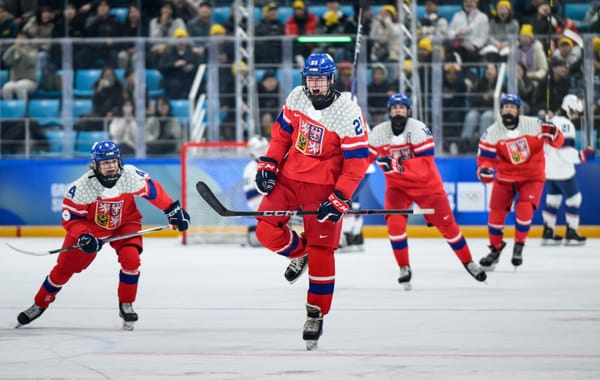It’s OK to be Disappointed with Lias Andersson For Now
But the future remains bright for the young Swedish center
Full disclosure: I do not believe that Lias Andersson is a bust. This needs to be implicitly understood by anyone who might be emotionally reacting to a headline before we go any further. Disappointing though is his failure to make the Rangers’ opening night line-up may be, the 19-year-old is still full of poise and promise that should translate to a rewarding NHL career. I whole-heartedly believe that. All of it.
Equally true, however, is the fact that for a second straight year since the Rangers selected him seventh overall in the 2017 NHL Entry Draft, Andersson left Blueshirts’ management wanting more. A dominant, two-goal game against the Devils early in the preseason, which set the stage for the kind of progress both fans and the front office were no doubt hoping to see, was disappointingly followed up by a string of mediocre performances as preseason came to a close. Games that no doubt cost him a job that was arguably his to lose in the first place.
“It’s a hard decision. It’s hard for him. Personally, I’d like to see him here, too, but the long game is better than the short one on this call,” Gorton told the media shortly after the team’s final cuts were made.
For any other teenaged prospect, little would be made of such a series of events if not for the fact that NHL-readiness — or the appearance of it — was a major factor in why New York opted to select him so high in the first place. The optics of which will only worsen should potential franchise center Casey Mittelstadt pay early dividends for the Buffalo Sabres, who selected him immediately after the Rangers exited the draft stage, Andersson in hand.
To be fair to Andersson, those would be circumstances well out of his control, but ones that would nonetheless affect the optics of both the decision to take him early and of his progress thus far.
Gorton mitigated the bad news some by talking about how Andersson is better served in a top-six — if not top-line — role with the Hartford Wolf Pack, rather than toiling on a Rangers fourth line that may only see “five, seven, or eight minutes.” Whether that’s true or not, however, is itself further mitigated when weighted against the fact he was drafted as a player on the immediate cusp of an NHL role.
”But sending him back is the right thing to do if we want to maximize where he is going and what he is going to be,” Gorton went on to say of the decision.
While other top-ten picks, like Mark Scheifele and Mikko Koivu, took years themselves to crack an NHL line-up, none were drafted with the kind of “NHL-ready” fanfare Andersson was. That matters. At least for now.
”If [Andersson] becomes an NHL staple in a month, three months or another year (or even two), no one will care about this particular assignment to the AHL,” said Larry Brooks of the New York Post, speaking in response to the news of Andersson’s demotion. Though his general assessment is correct, it still appeals to hope — something the Rangers were likely anticipating would have translated to reality by now.
The silver lining for Andersson, once he’s processed the disappointing news, of course, is that all of this can still be chalked up to growing pains, especially if he finds an early and productive footing with the Pack. It could even earn him an early call-up, particularly if either Filip Chytil, who was sent to the Pack after breaking camp with the team last season, or Brett Howden slip up or are shifted to wing.
Or, if this stretches out for months, perhaps a second post-trade deadline nod is all he’ll need to stick long-term. The Rangers are expected to be a more difficult team to play against this season, but still project as a bottom-third NHL club. That fact alone could force them to perform a second-straight sell-off at the deadline. One where perhaps veteran center Kevin Hayes could see himself shipped out – an event that could blaze a path for Andersson’s NHL return/aspirations.
None of this could possibly be painted as ideal, but Andersson’s inability to lock down an opening night roster spot also cannot be used to determine his selection a bust. Not yet, at least. And it’s unlikely to ever get to that point.
Though he shares some connective tissue to another first-rounder-turned-bust in Dylan McIlrath — both being taken in the top-10 for somewhat specious reasons like leadership and character — what Andersson has going for him regarding his game divorces him entirely from McIlrath. The latter not only missed the window to join the NHL during an era when plodding, physical defensemen were still highly-desired commodities, but never produced against men the way Andersson did playing against them in the SHL. While that’s not quite a guarantee of NHL success, it is the kind of factor that lends well to the likelihood of it. This can’t be understated, and remains one of the strongest indicators of Andersson’s viability.
For Andersson, the best thing he can do at this point is to quietly lick his wounds and heal up (or hide them) quickly enough to make an immediate impact in the AHL — preferably a lasting one. While the decision to cut him from the opening night roster was justified, ignoring a highly-productive player renowned for doing all the little things right isn’t a luxury the Rangers will be able to afford for long.
That may be all Andersson needs to shake off this setback, helping not only to begin his full-time NHL career but to brush this all into the dustbin of history, where it’s unlikely to ever be thought of again. After all, is there anyone left in Winnipeg or Minnesota still upset over the length of time it took Scheifele or Koivu to find their sea legs?
But until that happens, it’s OK to be disappointed in Lias Andersson. Right up until it’s not.





